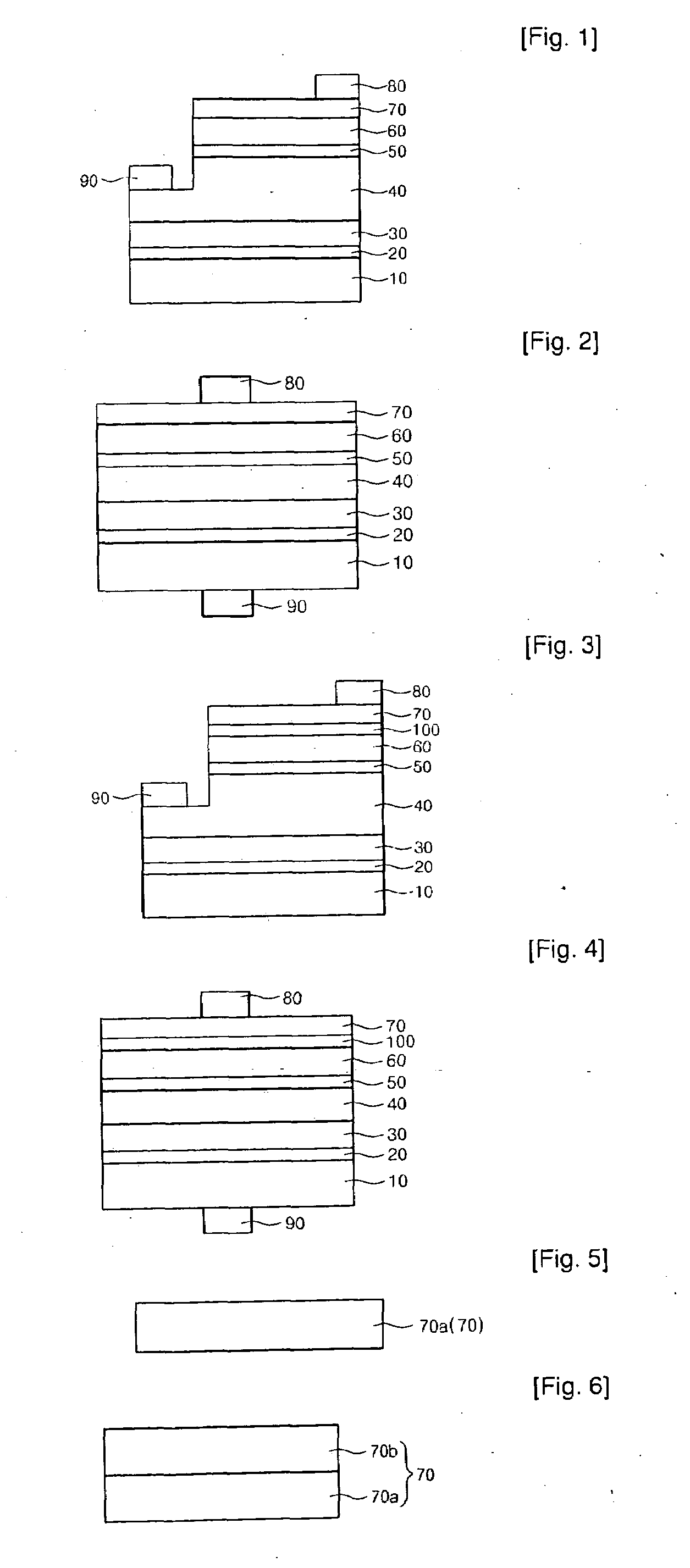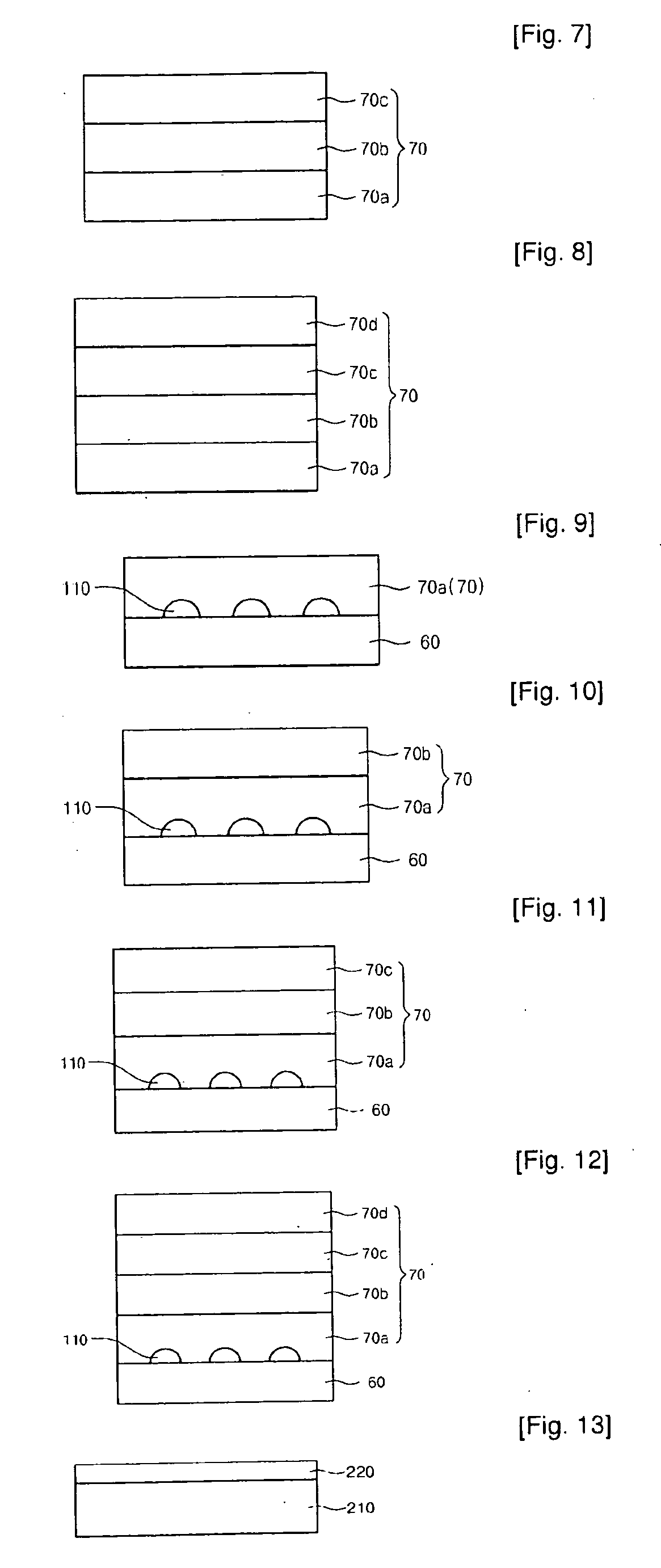Optical Device and Method of Fabricating the Same
a technology of optical devices and fabrication methods, applied in the field of optical devices, can solve the problems of low work function values, difficult hole injection, and difficult realization of leds with high external quantum efficiency (eqe), and achieve the effect of improving the ohmic contact characteristic and high efficiency
- Summary
- Abstract
- Description
- Claims
- Application Information
AI Technical Summary
Benefits of technology
Problems solved by technology
Method used
Image
Examples
first embodiment
[0043]FIG. 1 is a sectional view showing a top-emitting light emitting diode (TELED) having a p-type multi ohmic contact electrode structure according to the present invention, and FIG. 2 is a sectional view showing a top-emitting light emitting diode (TELED) having a p-type multi ohmic contact electrode structure according to a second embodiment of the present invention.
[0044]In detail, FIG. 1 shows the III nitride-based TELED stacked / grown on a sapphire substrate 10, which is an insulating growth substrate, and FIG. 2 shows the III nitride-based TELED formed on a conductive substrate including silicon carbide (SiC), zinc oxide (ZnO), silicon (Si), gallium arsenic (GaAs), a metal, such as copper (Cu), nickel (Ni) or aluminum (Al), or an alloy formed through electroplating or a bonding transfer scheme.
[0045]Referring to FIGS. 1 and 2, the III nitride-based TELED includes a substrate 10 on which a low-temperature nucleation layer 20, a nitride-based buffer layer 30, an n-type nitride...
third embodiment
[0061]FIG. 3 is a sectional view showing a top-emitting light emitting diode (TELED) having a p-type multi ohmic contact electrode structure according to the present invention, and FIG. 4 is a sectional view showing a top-emitting light emitting diode (TELED) having a p-type multi ohmic contact electrode structure according to a fourth embodiment of the present invention.
[0062]In detail, FIG. 3 shows the III nitride-based TELED stacked / grown on a sapphire substrate 10, which is an insulating growth substrate, and FIG. 4 shows the III nitride-based TELED formed on a conductive substrate including silicon carbide (SiC), zinc oxide (ZnO), silicon (Si), gallium arsenic (GaAs), a metal, such as copper (Cu), nickel (Ni) or aluminum (Al), or an alloy formed through electroplating or a bonding transfer scheme.
[0063]Different from the first and second embodiments of the present invention, the third and fourth embodiments of the present invention provide a stack structure in which a tunnel ju...
seventh embodiment
[0092]FIG. 15 is a sectional view showing a structure of a highly transparent n-type multi ohmic contact layer formed on an n-type nitride-based cladding layer according to the present invention, and FIG. 16 is a sectional view showing a structure of a highly transparent n-type multi ohmic contact layer formed on an n-type nitride-based cladding layer according to an eighth embodiment of the present invention.
[0093]In detail, FIG. 15 shows the highly transparent n-type multi ohmic contact layer 240 directly formed on the n-type nitride-based cladding layer 360, and FIG. 16 shows the highly transparent n-type multi ohmic contact layer 240 formed on the n-type nitride-based cladding layer 360 while interposing a tunnel junction layer 380 therebetween.
[0094]The seventh embodiment corresponds to the fifth embodiment and the eighth embodiment corresponds to the sixth embodiment, so detailed description for the same elements will be omitted below in order to avoid redundancy.
[0095]Referri...
PUM
 Login to View More
Login to View More Abstract
Description
Claims
Application Information
 Login to View More
Login to View More - R&D
- Intellectual Property
- Life Sciences
- Materials
- Tech Scout
- Unparalleled Data Quality
- Higher Quality Content
- 60% Fewer Hallucinations
Browse by: Latest US Patents, China's latest patents, Technical Efficacy Thesaurus, Application Domain, Technology Topic, Popular Technical Reports.
© 2025 PatSnap. All rights reserved.Legal|Privacy policy|Modern Slavery Act Transparency Statement|Sitemap|About US| Contact US: help@patsnap.com



